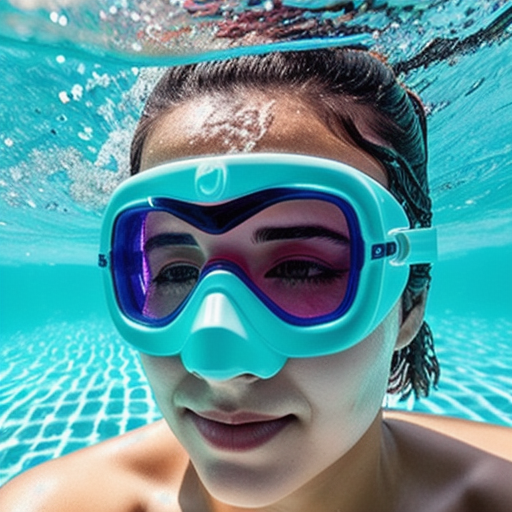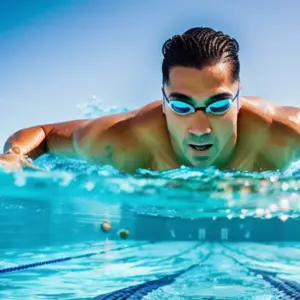As a passionate swimmer, I absolutely love that feeling of diving headfirst into the pool and gliding effortlessly through the water. There’s just one thing that can instantly take me from this blissful state to absolute frustration – foggy swimming goggles! What good is having the perfect stroke technique and powerful flip turns if you can’t see where you’re going? Fear not, fellow aqua enthusiasts, for we have embarked on a noble quest to end the foggy goggle plague once and for all! Join us as we dive into the depths of science and technology, unmasking all the secrets to anti-fog swimming goggles that will turn your underwater vision from cloudy to crystal clear. So, tighten your swim caps and fasten your goggles, let’s embark on this enlightening swim-scapade together!
Why goggles fog up when swimming
Swimming with clear visibility is essential for both safety and enjoyment. However, swimmers often face the challenge of foggy goggles, which can obstruct their view and disrupt their swimming experience. This fogging occurs due to a phenomenon known as condensation, which is caused by a combination of factors.
Firstly, the temperature difference between the swimmer’s body and the surrounding water plays a significant role in causing goggle fog. As swimmers exercise, their body temperature rises, generating heat. In contrast, the water in swimming pools or open bodies of water usually remains cool. This temperature disparity causes the warm, moist air from the swimmer’s face to meet the cold surface of the goggle lens, resulting in condensation or fogging.
Another contributing factor to foggy goggles is the humidity present in the environment, especially in indoor swimming pools. The warm, moist air inside the pool area can increase the chances of condensation formation on the goggle lenses. In addition, activities like breathing and sweating can also add to the humidity and consequently contribute to goggle fogging.
Understanding the science behind foggy swim goggles helps to identify effective anti-fog measures, such as pre-wetting the goggles, using anti-fog solutions, or selecting goggles with built-in anti-fog protection. Swimmers who are conscious of these factors and invest in proper goggle care can minimize fogging issues, resulting in an uninterrupted and satisfying swimming experience.
Benefits of anti-fog goggles
In today’s competitive and fitness-conscious world, swimming has become a popular sport and recreational activity for people of all ages. One of the essential pieces of equipment for any swimmer is a good pair of goggles. With advancements in technology, anti-fog swimming goggles have emerged as a must-have swim accessory. These goggles offer several benefits that contribute to a more enjoyable and uninterrupted swimming experience.
Firstly, anti-fog swimming goggles provide a clear and uninterrupted vision underwater. Traditional swim goggles are prone to fogging up due to the temperature difference between the swimmer’s body heat and the cooler water. This can obstruct the swimmer’s vision, making it difficult to see the pool lanes, other swimmers, or any obstacles in their path. Anti-fog goggles have a special coating that prevents the condensation from forming, ensuring crystal-clear vision throughout the swim.
Secondly, by providing unobstructed vision, anti-fog goggles significantly enhance the safety aspect of swimming. Swimmers can be more aware of their surroundings, which reduces the risk of collisions or accidents in the water. This is particularly important for those participating in open water or competitive swimming events.
In addition to improving visibility and safety, anti-fog swimming goggles also offer more comfort and convenience. Swimmers no longer need to pause their swim frequently to clear foggy lenses. This translates to a more seamless and enjoyable swimming experience, allowing swimmers to focus on their performance and technique.
Overall, investing in a pair of high-quality anti-fog swimming goggles is a wise decision for swimmers of all levels. The benefits of clear vision, enhanced safety, and added comfort make them an indispensable asset for a fulfilling swimming experience.
Cost-effective solutions for anti-fogging
There are numerous cost-effective solutions to prevent fogging in swimming goggles while maintaining clear vision underwater. These methods are not only pocket-friendly but also easy to adopt and can improve your overall swimming experience.
1. Saliva:
Swimmers all around the world have utilized this DIY method to make their goggles fog-free. Human saliva acts as a surfactant and helps in breaking the surface tension, preventing fog molecules from sticking together. Simply apply a tiny amount of saliva on the inside of your goggle lenses and spread it evenly. This method may offer temporary results, but it is highly effective and comes at no cost.
2. Baby shampoo:
Another inexpensive solution is applying baby shampoo on the inside of the goggle lenses. Baby shampoo acts as a barrier between the lenses and condensation, preventing fogging. Ensure that you are using a minimal quantity and rinsing off any excess shampoo to avoid eye irritation. Also, since baby shampoo is gentle on the eyes, it is preferred over regular shampoo.
3. DIY defoggers:
Household items such as liquid soap, toothpaste, or shaving cream can help in keeping the goggles fog-free. Simply rub a tiny amount of the product on the inside of the lenses and rinse off the excess. Make sure that you use scent-free or chemical-free products to avoid any potential irritation to your eyes.
4. Anti-fog spray:
Although a slightly pricier option than the aforementioned solutions, investing in an anti-fog spray is still cost-effective compared to buying a new pair of goggles. Spraying a small amount of this solution on the lenses will help in maintaining a clear vision underwater.
By incorporating these cost-effective solutions into your swimming routine, you can avoid the hassle of foggy goggles and enjoy a more comfortable swim.
How to Use Saliva as an Anti-Fog Solution for Swimming Goggles
Swimming goggles tend to fog up when there’s a difference in temperature between the lenses and the surrounding water or air. This can be quite annoying, especially if you’re in the middle of a leisurely swim or a competitive race. Numerous anti-fog solutions exist to help prevent this pesky occurrence, including one that’s easy to access, natural, and affordable – saliva!
While it may sound quirky and unconventional, using saliva to prevent fogging in swimming goggles has proven to be an effective method for many swimmers. It works by creating a barrier on the lens, which breaks up the condensation into droplets that roll off rather than form a foggy layer. Not only is it a cost-effective solution, but it’s also exceedingly practical – after all, you’re always carrying it with you! Additionally, since saliva is a natural substance, it’s suitable for those with sensitive eyes who may not do well with harsh chemicals.
To use this method, simply remove your goggles, collect saliva in your mouth, and spread it evenly across the lenses with your fingers or a clean cloth. Once you’ve covered the entire surface, gently rinse the lenses in water without touching them to remove any excess saliva. After that, it’s time to put those goggles back on and enjoy a fog-free swim.
In summary, using saliva as an anti-fog solution for swimming goggles is a practical, budget-friendly, and natural option. However, it’s essential to keep in mind that other preventive measures, such as maintaining your goggles and using a compatible anti-fog spray, can increase their longevity and ensure a clear vision in the water. Happy swimming!

How to Use Baby shampoo for anti-fogging properties
One surprisingly effective method to prevent swimming goggles from fogging up is using baby shampoo for its anti-fogging properties. Baby shampoo is a gentle, inexpensive, and readily available substance that has been proven to work remarkably well in keeping goggles clear of fog. Since it is formulated for babies, this shampoo is tear-free, making it safe to use on your goggles without irritating your eyes.
To use baby shampoo as an anti-fogging agent, simply follow these easy steps: First, ensure your swimming goggles are clean and dry. Next, take a small drop of baby shampoo and gently rub it onto the inner surfaces of your goggles’ lenses. Be sure to cover the entire lens area with a thin, even layer of the shampoo. Once this is done, allow the lenses to air dry for a few moments. Finally, carefully rinse the goggles with water to remove any excess shampoo, taking care not to touch the inner surfaces of the lenses with your fingers. This will prevent smudging and ensure maximum anti-fogging capabilities.
The thin layer of baby shampoo left behind on the lenses after rinsing creates a barrier that prevents condensation from forming, thus keeping your goggles fog-free. This method has been utilized by swimmers and divers alike for its simplicity and effectiveness. It’s important to note, however, that this solution may need to be reapplied periodically for optimal results, especially if you often swim for extended periods. Overall, baby shampoo is a safe, affordable, and efficient way to keep your swimming goggles fog-free, allowing you to focus on your swim without any visual distractions.
How to Use anti-fog spray
When it comes to enjoying a comfortable and fog-free experience in the swimming pool, using an anti-fog spray on your swimming goggles can make all the difference. To ensure reliable anti-fog performance, it is essential to select a high-quality spray that adheres well to the lens surface. The following steps will help you apply the appropriate anti-fog spray effectively:
1. Clean the swimming goggles: To start, make sure that your goggles are clean. Dirt specks and body oils can provide perfect attachment points for fog droplets. Use a non-abrasive cleaner (such as a mixture of vinegar and water) on the lens, avoiding the use of your fingers, as they may leave behind additional residues.
2. Rinse the lens with hot water: Rinsing the lens in hot water will help remove any lingering dirt or residue, ensuring a clean surface for the anti-fog spray application.
3. Apply the anti-fog spray: Spray the inside surface of the swimming goggles lens with a generous and even coating of the anti-fog solution. You may need to move the lens around to ensure an even application.
4. Rinse the goggles: After applying the anti-fog spray, rinse the goggles with water to ensure the solution is distributed evenly across the lens surface.
By following these simple steps, you’ll be well on your way to a clear, fog-free swimming experience. Remember, the key to success lies in selecting a high-quality anti-fog spray and maintaining a clean lens surface, which will prevent fog droplets from attaching themselves to the goggles. So, use an anti-fog spray on your next swim, and enjoy a crystal-clear view underwater!
Use Toothpaste as an alternative
For many swimmers, foggy goggles can be a real nuisance, obstructing vision and hindering performance. In addition to the commercially available anti-fog products, there is a surprising household alternative that can be just as effective: toothpaste. Yes, toothpaste! However, it is essential to use this method with caution to avoid damaging the goggle’s anti-fog coating.
The idea of using toothpaste to prevent fogging originated from the scuba diving community. Divers found that toothpaste could diminish mask fogging by cleaning and removing tiny imperfections or dirt build-up on the tempered glass surface of diving masks. This approach might not always be suitable for swimming goggles, as they are typically made of plastic and have a built-in anti-fog coating.
Toothpaste has an abrasive quality, and using it on your swimming goggles may potentially damage the anti-fog coating if not done correctly. To avoid harming this delicate layer, it is crucial that you use only a small amount of non-abrasive toothpaste and rub it gently on the inner surface of the lenses. After applying the toothpaste, rinse the goggles thoroughly under water to remove all residue, ensuring that no toothpaste gets into your eyes while swimming.
While this method might not be ideal for all swimmers, it could provide a temporary, cost-effective solution to foggy goggles. However, it is essential to note that this method might work best for goggles with low-quality or already damaged anti-fog coatings. For optimal results, swimmers are advised to invest in high-quality goggles and proper anti-fog products. Overall, toothpaste can be a viable alternative when used with caution and proper technique.
Using cold water to prevent fogging
Swimming goggles have a tendency to fog up due to the temperature difference between the cold water and the heat that is generated by our bodies. This fogging can become a major obstacle for swimmers, obstructing their line of sight and causing discomfort during practices or swim competitions. Thankfully, using cold water can help significantly in reducing the chance of fogging, ensuring a clear field of vision throughout your swimming sessions.
To prevent your goggles from fogging up, begin by wetting your face with cold water just before you put your goggles on. This step helps to reduce the temperature difference between your face and the pool water, which is one of the main causes of fogging. Once your face has acclimatized to the cooler temperature, put on your swimming goggles and enjoy a fog-free experience.
In addition, wetting your goggles in cold water before putting them on can also aid in minimizing fogging. This allows both your face and the goggles to maintain similar temperatures and prevents moisture from accumulating inside the goggles, thereby reducing the risk of fogging. Make sure to dip your goggles into the cold water, ensuring that the lenses are entirely immersed, and then put them on.
By incorporating this simple cold water trick in your pre-swim routine, you can achieve a fog-free swimming experience, ultimately improving your performance and overall enjoyment in the pool. Remember, maintaining a clear line of sight is essential for a safe and successful swim, so be sure to take preventative measures against fogging to ensure optimal visibility.
Importance of proper care for anti-fog lenses
Swimming goggles with anti-fog lenses are an essential piece of equipment for swimmers, aiding in clear vision while in the water. These lenses aid in preventing the condensation of water vapor on the inner surface, allowing the wearer to enjoy uninterrupted swimming sessions. However, to ensure the lasting effectiveness of these lenses, it is crucial to take proper care of them. Maintaining and caring for anti-fog lenses is not only vital for their longevity but also for the overall swimming experience.
One of the primary aspects of taking care of anti-fog lenses is to avoid rubbing the interior of the goggles, as this can damage the anti-fog coating. Instead, you can use anti-fog sprays or other alternative solutions, such as saliva or toothpaste, to prevent fogging effectively. It is also essential to rinse the goggles after each use with cold freshwater to remove chlorine and other pool chemicals, which can degrade the lens coating over time.
Drying the goggles properly after use is also a critical aspect of lens care. Make sure to spread them out flat in a cool and shaded place to dry, avoiding direct sunlight or heat sources that can cause the lens or rubber parts to crack or melt. Additionally, always store the goggles in a protective case to prevent scratches and damage to the delicate lens surface.
Proper care of anti-fog lenses not only extends the lifespan of the swim goggles but also ensures optimal visibility during swims. By following these simple yet effective care practices, swimmers can dramatically enhance their swimming experience and protect their valuable gear.
10. Other useful tips for preventing swim goggles from fogging up
Swimming goggles fogging up can put a damper on an enjoyable swim session. Although some goggles come with a pre-applied anti-fog coating, it may wear off over time, making it essential to find alternative solutions. Here are ten useful tips to help prevent your swim goggles from fogging up:
1. Always rinse your goggles with freshwater after each swim session to remove any chemicals and dirt that can contribute to fogging.
2. Allow your goggles to air dry, away from direct sunlight. Storing your goggles in a dark, cool environment helps preserve the anti-fog coating.
3. Avoid touching the lenses with your fingers as oils from your skin can leave smudges, contributing to fogging.
4. Invest in a quality pair of goggles with a secure seal to prevent moisture from entering, which can cause fogging.
5. Use a high-quality anti-fog spray or wipes explicitly designed for swim goggles to add a protective coating that minimizes fogging.
6. Apply a thin layer of baby shampoo or hair conditioner on the lenses, creating a barrier to prevent condensation from forming. Be sure to rinse it off thoroughly before swimming.
7. Gently rub a small amount of toothpaste on your lenses, which can also help in preventing condensation. Rinse it off before you dive into the water.
8. Splash your face with cold water before putting on your goggles to minimize the temperature difference between your face and the water, thereby reducing fogging.
9. Adjust your goggles to ensure a snug fit around your eyes, minimizing the entry of air and moisture, which can cause fogging.
10. Regularly maintaining and cleaning your goggles not only prevents fogging but also prolongs the lifespan of your swim gear.
By following these tips, you can ensure clear vision throughout your swim, making your time in the water more enjoyable and productive. Happy swimming!




